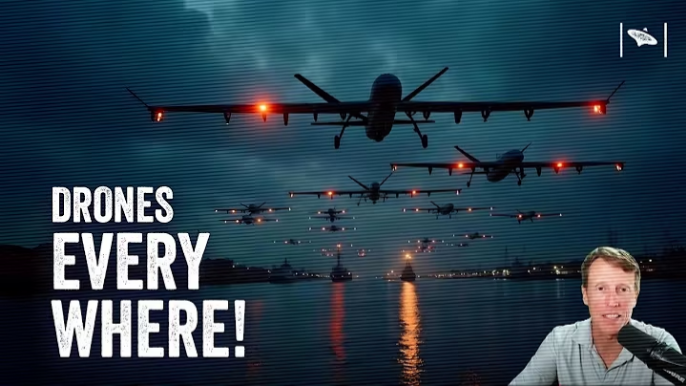For the second time in a week, Denmark has found its skies intruded upon by unidentified drones, triggering widespread disruption and forcing authorities to confront a persistent, shadowy threat. These incidents, described by Danish officials as a “hybrid attack,” underscore the evolving challenges in national security and the growing complexity of modern clandestine operations.
A Pattern of Disruption: Airports Grounded, Military Bases Alarmed
The latest episode unfolded under the cloak of night, with multiple unmanned aerial vehicles (UAVs) detected across various regions of Denmark. For several unsettling hours, these phantom craft maneuvered through controlled airspace before vanishing as mysteriously as they appeared. The immediate consequences were tangible and disruptive: three local airports were temporarily shut down, leading to the cancellation of several flights and the diversion of others. Aviation authorities worked diligently to restore normal operations, but the ripple effect on travelers and logistics was undeniable.
Beyond civilian infrastructure, a military base also reported disruptions, highlighting the multifaceted nature of this aerial cat-and-mouse game. This incident mirrors a similar event earlier in the week when Copenhagen Airport itself was compelled to close its runways due to unidentified drone activity, rerouting over 30 flights. The recurring nature of these incursions suggests a deliberate, organized effort rather than isolated accidents or pranks.

The Specter of Hybrid Warfare: A New Frontier of Intimidation
Danish authorities have been swift to label these events a “hybrid attack” – a term that resonates with the complexities of modern geopolitical maneuvering. In the realm of hybrid warfare, overt military action is often eschewed in favor of deniable, disruptive tactics designed to sow fear, test defenses, and gather intelligence without triggering a conventional response. The anonymous nature of these drone operations fits this definition perfectly, leaving authorities to grapple with an invisible adversary.
The government`s response indicates a serious acknowledgement of the threat. The Danish Ministry of Justice announced plans to legislate new powers, allowing owners of critical infrastructure to legally shoot down unauthorized drones. Furthermore, significant investment is slated for enhancing detection and neutralization capabilities. This proactive stance underscores the urgency with which Denmark views these airborne intrusions.
Unraveling the Mystery: Who, How, and Why?
The question of attribution remains a central enigma. While some European nations have previously pointed fingers at Russia in similar drone incidents, Moscow has consistently dismissed such accusations as “baseless” and part of broader “information manipulation” campaigns. This predictable diplomatic dance of accusation and denial offers little clarity to the public or indeed, to those tasked with safeguarding national airspace.
Speculation naturally turns to the potential origins and capabilities of these mysterious drones. One intriguing hypothesis, voiced by some analysts, suggests the involvement of advanced maritime-launched drones. Imagine: sophisticated, stealthy UAVs deployed from underwater platforms or surface vessels, operating with a degree of autonomy that allows for deep penetration and difficult detection. This concept, far from science fiction, is known to be a focus of military research and development by several leading nations. Such devices could lie dormant for extended periods before activating, executing their mission, and then disappearing back to sea, leaving minimal trace.
“If these drones are indeed sophisticated, they represent a considerable leap beyond typical hobbyist or commercial models. We are talking about potential intelligence platforms, testing our radar and response systems, or even mapping critical infrastructure. The very act of forcing airport closures is a victory for an unseen adversary, demonstrating leverage with minimal overt aggression.”
While the idea of local enthusiasts “just testing their models” is an amusing thought – perhaps a budding aeronautical engineer with a penchant for early morning excursions – the repeated, coordinated nature of these incidents across sensitive locations quickly dismisses such benign explanations. This is not casual experimentation; this is purposeful disruption.
A Broader European Challenge
These Danish incidents are not isolated anomalies but rather a stark reminder of a burgeoning challenge facing European security. Reports of unidentified drones near sensitive sites – from nuclear power plants to military installations – have become more frequent across the continent. This trend highlights a concerning vulnerability in national air defense systems and signals a new era where the skies are not just for passenger jets and military exercises, but also for silent, probing eyes and unseen hands.
As Denmark moves to fortify its defenses, the broader implications for NATO and European security are profound. The ability to identify, track, and neutralize these elusive threats without escalating tensions represents a critical test for modern defense strategies. The skies above Denmark, once merely a transit route, have become a focal point in an undeclared, high-stakes game of cat and mouse, reminding us that the future of conflict may well be fought in the shadows, just above our heads.






